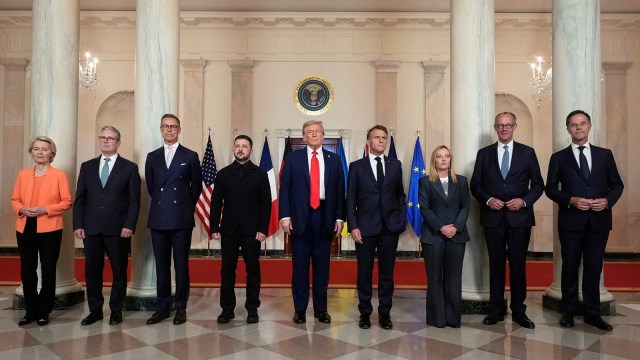
By Aleksei Zakharov
The paucity of detail and confidentiality surrounding the outcomes of the summits in Alaska and Washington DC, held on August 15 and 18, respectively, hints that something major is in the works. The meeting between US President Donald Trump and Russian President Vladimir Putin is generally perceived as a success for the latter, who not only managed to break through Western isolation to receive a red-carpet reception, but also exploited the talks to once again push his agenda on Ukraine. It is also believed that Putin outplayed Trump with regard to the specifics of conflict resolution: He escaped a new round of US sanctions, which the US president had promised in the event of no deal being reached, without making too many commitments of his own. Following their three-hour conversation, Trump suddenly shifted his position, promoting a peace agreement rather than a ceasefire as the immediate goal. This aligns with Moscow’s vision but contradicts Kyiv’s demands for the advancement of talks.
The question of what Moscow has pledged to the US in return is a salient one. Judging by the Trump administration’s vague comments, Russia agreed to “robust” security guarantees for Ukraine, specifically the provision of an “Article 5-like protection” by the US and Europe. While the details of this arrangement are yet to be determined, Washington’s involvement in this process might mark a departure from Trump’s earlier stance.
Currently, there is hardly any alignment on “security guarantees” between the conflicting sides. While European leaders are mulling various options, ranging from further strengthening the Ukrainian army to boosting its military production and deploying troops on the ground, Trump repeatedly says that the US is willing to sell more weaponry to Ukraine via Europe but will probably not go beyond efforts at “coordination”. Even if Washington rules out sending its troops, all of these steps appear unacceptable for Putin, who has not wavered in his vision of a neutral or “demilitarised” Ukraine. In a sense, demilitarisation of Ukraine is the “security guarantee” that Putin has been seeking, though Kyiv’s acquiescence to this in the current stalemate seems unlikely.
Another key item on the agenda and a potential stumbling block is the “land swap” issue which US special envoy Steven Witkoff described as “the crux of the deal.” While the terms of the offer remain unclear, Witkoff outlined that Kyiv was expected to cede the territories of Donbas in exchange for Russian concessions in other regions. This is on top of Washington’s apparent acceptance of Russia’s control of Crimea as a fait accompli. Convinced of its military superiority, Moscow is exploiting its territorial gains as leverage in negotiations. Putin has previously warned that if Ukraine does not accept his preconditions for ending the war, the advancement of the Russian army will leave Ukraine in an even worse situation.
The territorial issue is also sensitive for political reasons. Both Ukraine and Russia enshrine the disputed territories in their constitutions, so any territorial concessions in the five regions in question (Luhansk, Donetsk, Zaporizhzhia, Kherson and Crimea) would require a thorny legislative process. This puts President Volodymyr Zelenskyy in a vulnerable position, as surrendering Ukrainian lands could jeopardise his political ambitions in the presidential elections that would follow the peace agreement.
Trump’s shuttle diplomacy between Russia, Ukraine and Europe has paved the way for direct communication between Moscow and Kyiv. While their previous rounds of talks were moderately successful, resulting in the exchange of prisoners of war, they failed to bridge the positions of the two warring parties. The new goal is a summit between Zelenskyy and Putin which looks like a half-baked idea. The Kremlin has not rejected the possibility of a meeting, but has offered to first elevate the level of the Russian and Ukrainian delegations for new talks in Istanbul, thereby retaining an element of ambiguity.
While Trump is rushing to secure another “peace deal” before the Nobel Prize announcements on October 10, Putin is under no time constraints or domestic pressure. The Russian president is granting concessions to Trump, recognising that the latter’s presidency is a once-in-a-lifetime opportunity to improve Russia-US relations and reach an understanding on broader strategic issues. Moscow has offered Trump various sweeteners such as joint projects in the Arctic and the access to reserves of critical minerals. Just a day before the Alaska meeting, Putin signed a decree allowing the US oil major Exxon Mobil to regain its shares in the Sakhalin-1 oil and gas project. Essentially, US-Russia relations have transitioned from confrontation to engagement, though progress in their dialogue has been limited even on technical issues such as the restaffing of embassies and resolving visa issues.
The war in Ukraine remains hard to untangle and will require much patience and quiet diplomacy. While Russia and Ukraine are showing conciliatory signs, primarily in an attempt to win Trump over to their side, there are no good solutions to the conflict. Despite diplomatic overtures, a peace deal is still unlikely. Neither the US nor Europe has the sufficient leverage to pressure Moscow, and Russia has been unable to coerce Kyiv into making peace on its own terms. In this impasse, attempts to craft an imperfect peace will go hand in hand with a protracted war.
The writer is a Fellow with the Strategic Studies Programme at Observer Research Foundation